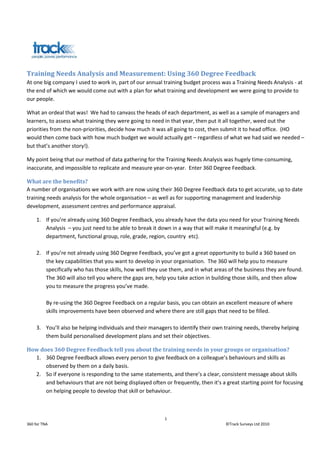360 for training needs analysis
- 1. Training Needs Analysis and Measurement: Using 360 Degree Feedback
At one big company I used to work in, part of our annual training budget process was a Training Needs Analysis - at
the end of which we would come out with a plan for what training and development we were going to provide to
our people.
What an ordeal that was! We had to canvass the heads of each department, as well as a sample of managers and
learners, to assess what training they were going to need in that year, then put it all together, weed out the
priorities from the non-priorities, decide how much it was all going to cost, then submit it to head office. (HO
would then come back with how much budget we would actually get – regardless of what we had said we needed –
but that’s another story!).
My point being that our method of data gathering for the Training Needs Analysis was hugely time-consuming,
inaccurate, and impossible to replicate and measure year-on-year. Enter 360 Degree Feedback.
What are the benefits?
A number of organisations we work with are now using their 360 Degree Feedback data to get accurate, up to date
training needs analysis for the whole organisation – as well as for supporting management and leadership
development, assessment centres and performance appraisal.
1. If you’re already using 360 Degree Feedback, you already have the data you need for your Training Needs
Analysis – you just need to be able to break it down in a way that will make it meaningful (e.g. by
department, functional group, role, grade, region, country etc).
2. If you’re not already using 360 Degree Feedback, you’ve got a great opportunity to build a 360 based on
the key capabilities that you want to develop in your organisation. The 360 will help you to measure
specifically who has those skills, how well they use them, and in what areas of the business they are found.
The 360 will also tell you where the gaps are, help you take action in building those skills, and then allow
you to measure the progress you’ve made.
By re-using the 360 Degree Feedback on a regular basis, you can obtain an excellent measure of where
skills improvements have been observed and where there are still gaps that need to be filled.
3. You’ll also be helping individuals and their managers to identify their own training needs, thereby helping
them build personalised development plans and set their objectives.
How does 360 Degree Feedback tell you about the training needs in your groups or organisation?
1. 360 Degree Feedback allows every person to give feedback on a colleague’s behaviours and skills as
observed by them on a daily basis.
2. So if everyone is responding to the same statements, and there’s a clear, consistent message about skills
and behaviours that are not being displayed often or frequently, then it’s a great starting point for focusing
on helping people to develop that skill or behaviour.
1
360 for TNA ©Track Surveys Ltd 2010
- 2. To use 360 Degree Feedback for Training Needs Analysis:
Re-use any tools you have already developed, such as KPI’s, competencies, as a starting point for your 360
Degree Feedback.
Your 360 Degree Feedback should:
- Focus on a small group of key capabilities (these can be tailored for different groups or areas of the
business)
- Contain statements that clearly describe what those key capabilities look like
- Provide a clearly measurable scale that will help you to see where there is a need for training or
development
By aggregating the 360 Degree Feedback results for a group, department or the whole organisation, you
can spot trends and patterns that indicate a need for intervention, whether that were training,
development or coaching.
Here’s a sample showing the scores for one group, and their core competencies (as assessed by their
colleagues and managers), from top to bottom (top score is 5). From this we would analyse in more depth
and details the feedback on Managing the Team and Managing Self.
2
360 for TNA ©Track Surveys Ltd 2010
- 3. Here’s another sample showing the bottom 5 scoring statements for the group, which indicates areas for
further analysis or action, are goal setting, delegating and feedback.
For a more in depth analysis, you can look at the feedback the group has received from different
respondent groups about specific key capabilities and skills, as in the following examples:
if you’d like more information on how to use 360 Degree Feedback to measure your training needs and your
training results, contact us for a chat, at jo.ayoubi@tracksurveys.co.uk, or on +44(0) 20 7207 7279.
3
360 for TNA ©Track Surveys Ltd 2010

